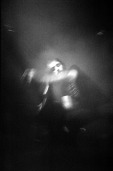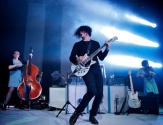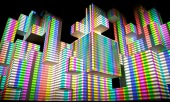Animal Collective
I covered Animal Collective at Field Day 2013 festival, the Brooklyn band was the headliner of the big stage back in May.
It looked this was the begin of a summer of festivals for them but the band announced the cancellation of the entire summer tour for illness.
The collective went, but thankfully the summer stayed. Get well soon folks!

I cherry picked some of the photos I took on the night, not really my best set to be fair and not really my fault. (photographer on the defensive looking for excuses… is at the photo tip below) to fulfil the void the Animal Collective missing tour creates… erm…wait a second… Does it create a void?

I planned to write this post following Mumford and Sons‘ but I avoided two negative posts in a row. Don’t want to make this a blog of rants by a middle age man pretending to be half his age.

So let’s start from New York. I love that city and its people.
Music-wise New York has always rivalled with London for the top of the seminal rock trends since Andy Warhol sponsored the Velvet Underground. In decades the two cities alternated on top but this century the debate was silenced by the overwhelming influence of the big apple.
Only a coincidence, it was indeed with the Yeah Yeah Yeahs (and the Strokes) that New York scene kept the garage alive despite the CBGB didn’t survive the post 9/11 changing times.

In parallel, on the arty side of town, crossed Manhattan Bridge, Brooklyn generated a flow of ‘collectives’. Usually they are larger than usual ensembles with a supercool look.
Despite the Factory and Warhol are long gone, and differently from the snobby London art scene, in New York the link between contemporary art and music never stopped.
Pitchfork has been the ambassador of this sounds. The high marks for most albums coming from here, constantly above their 8.0 plus plenty of Best New Music tags attached, shaped the music of Brooklyn and the taste of their readers.

Grizzly Bear and Animal Collective are the two major examples of this scene but it would be a simple exercise to mention few more that, either with a ‘twist’ or with an ‘edge’, can be added to the collection.
Sufjan Stevens? Liars? Dirty Projectors? Yeasayer? TV On The Radio?
In a way or the other all of these mix in different proportions electronics, dance sampling, world influences and experimental singing under the roof of a more traditional alternative-rock song structure.

If you know me, you also know I am not into melting pots. I may be a radical, or even orthodox, but I always prefer minimalist, simple music.
I am not Pitchfork so even without my support the impact on the scene of these bands is undeniable and the contribution they had in evolving rock scene into the third millennium, mostly around the end of the first decade, has been essential.
Animal Collective recorded about ten albums plus Eps, Live and the usual bunch of rarities attached to seminal bands.

In recent months and after some less than exciting releases I feel that the invasion of these bands named after animals and in particular any species of bear identified by zoologists, is approaching the finishing line.
What, thanks to all the ingredients, looked an endless source of creativity and great music is quickly expiring. Even Pitchfork, “quoque tu”, had to stretch to concede a 7.4 for Centipede HZ , their latest release.
The vein, naturally generated too many bands that have become hard to distinguish one from the other and from themselves.
It is a music that still sound good to soundtrack the next exhibition opening or an organic wine tasting, but is unable anymore to keep the attention with just its presence.

The huge stage where Animal Collective where about to stand at Field Day proved this. And resized them.
Under huge inflatables teeth and kaleidoscopic lights the band came on stage with the audience distracted playing with colourful, bouncing balloons, and not showing the urgency of listening to their music.

In such an anti-climax the band does everything wrong. They stands on the highest of stages which is far away from the barriers. They are far away from the front and even far away from each other. With no interaction between them and no connection with the public the concert never managed to take off.

I understand the pose of looking concentrated, the desire of communicating to fans only through music, but from 3 meters high and twenty or more meters away from the first row, they had to have a great view on the fans. It is impossible to not notice the constant flow of people walking away from the stage and out of Victoria park toward the closest tube station.

Yet, they changed nothing. Total loss of engagement, song after song, all sounding well played but plain and samey. In a word, boring. There is not an highlight in their set, just the good minimum-wage performance.
The band only achievement was to disperse the attendants in a smooth stream after the exit arrow avoiding congestion.

When this happens at a concert I get out disappointed. If it happens at a festival I simply forget to have seen Animal Collective and remember the other good bits of a great day of music.
Let’s see if cancelling the tour get them more time to think more of how to please their fans rather than only themselves.
Follow Animal Collective here: [website][facebook][twitter][spotify]

Photo tip
I have already wrote about the difficulties of the photo policy at Field Day 2013 along my post about Daughter. Can’t do much more than complain.
The policy of letting only 12 photographers in a pit for 3 songs was silly for the small tents and looked ridiculous on the big stage which could host 50+. I had been waiting almost a hour to get into this pit, unable to shoot other bands, to avoid missing the headliners.
Big stages are one of the reasons why I don’t like photographing big events.

It is very difficult to portray the interaction of the band with the fans if the only way to frame an image is to use a long telephoto with an angle tilted by the extremely elevated position of the performer which stands far away behind a guitar or drum or, worse, keyboard that hides the figure.
The advantage of big stages, on the other side, is that usually they are greatly lit. Not the case tonight. Animal Collective light designer concentrated on magenta/green pairs. All generated by led lights unique to saturate camera sensor channels.
Consequence weird unusable all magenta raws with hours to spend on a computer to convert either to digital black and white (how much I hate it I can’t say) or acrobatic white balancing make the real unreal.

With 2 of the band members standing (hiding?) on the back of the huge stage and the other 2 on the extreme sides the option to frame the whole band was a chimera and the one to have a close-up possible only with a 400mm and a tripod (not allowed).
Not allowed was even to climb the many elevated points to get a fairer angle. Health and safety, you know.
Conclusion is that you would struggle to find a decent photo of Animal Collective show at Field day this year, but you;ll find many of the colourful balloons that were keeping the people happy.









Your photos, especially the first few of Animal Collective, are wonderful. I got discouraged by the oversaturated lights and distance of the performers from the stage really early on and made to leave the festival. My boyfriend was dancing in the crowd to them, cause he loves AC, and I only went back to meet with him. What a change a few songs make! Seeing the band from the back of the crowd was much better, and the lights show improved vastly after the 3 song cut off. Do bands do this on purpose?? But by then I had been beat by exhaustion and ennui. I didn’t get my camera back out, I just tried to comprehend the weird, discordant melodies they were producing.
Do you shoot raw? The only thing I do to the original raw is to pick a white/grey/black area and set it as neutral grey. Sometimes it works. Some other it is just impossible.
Do they do it on purpose? Don’t know, but I’m fairly sure Nick Cave does.